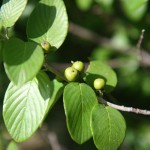Coyotillo
Karwinskia humboldtiana (Schult.) Zucc.
Rhamnaceae
Description
Coyotillo is a spineless woody shrub or small tree of the Buckthorn family. Plants on rangelands are generally 1 to 5 feet or 0.3 to 1.5 m tall, with crown diameters up to 10 feet or 3 m. The most distinctive feature of this plant is the leaves, which are opposite and have prominent veins ending at the leaf's untoothed margin. Small greenish flowers are produced in the leaf axils from July to September. The flowers have a five-lobed calyx, five petals, five stamens, and a compound pistil. The ovary develops into a brownish-black, oval-shaped fruit or drupe. The fruits mature in late summer and fall. Due to its high toxicity, Coyotillo has little value for wildlife or livestock. Some wildlife will consume the fruit including Coyotes and Chachalacas.Habitat
Coyotillo grows along arroyos and canyons and on gravelly hills and ridges. It is found from southwest Texas into Mexico and southern California. Native habitats include prairies, plains, pasturelands, and savannahs.Toxic Agent
Coyotillo contains four toxins identified as dimeric anthracenones thought to be responsible for its toxicity. This plant is toxic to cattle, sheep, goats, hogs, horses, and fowl; cattle are the most susceptible. It is also toxic to humans. Coyotillo toxins primarily cause damage to the nervous system, liver, lungs, and kidneys. Consumption of 0.05 to 0.3 percent of an animal's weight in seeds will cause poisoning. The leaves are much less toxic, requiring consumption of 15 to 21 percent of the animal's weight for poisoning. Seeds and leaves produce two different poisoning syndromes. There is usually a lag period of days or weeks between seed ingestion and the appearance of livestock signs. Problems from browsing this shrub occur most often in fall and winter.Signs of Livestock Ingestion
Signs of seed ingestion include: Exaggerated high stepping; Jumping or moving backward; Weakness and incoordination of hind legs; Dragging motion while walking; Complete prostration; Death. Signs of foliage ingestion include: Loss of condition; Wasting; Nausea; Progressive weakness; Death.Management Strategies
No effective medical treatment is known for Coyotillo poisoning. Other treatments may include a combination of physical therapy and supportive care but may not be successful for complete recovery. Few animals paralyzed from eating the seed recover under range conditions. Do not turn animals (especially goats) unfamiliar with Coyotillo into infested areas when this shrub is producing fruit. Proper stocking and good supplemental feed and mineral programs help reduce the incidence of poisoning.Images
Plant Characteristics
Flower Color: Green
Seed Type: Fruit/Berry
Duration: Perennial
Stem Texture: Hairless/Smooth
Growth Habit: Shrub (Woody)
Leaf Shape
 : Simple with Pinnate or Parallel Venation
: Simple with Pinnate or Parallel Venation
Season: Warm
Distribution
 : 02 - Gulf Prairies and Marshes, 05 - Cross Timbers and Prairies, 06 - South Texas Plains, 07 - Edwards Plateau, 10 - Trans-Pecos
: 02 - Gulf Prairies and Marshes, 05 - Cross Timbers and Prairies, 06 - South Texas Plains, 07 - Edwards Plateau, 10 - Trans-Pecos
Distributions
Distribution refers to the ecological region in Texas that a plant has been found. You can also view a clickable map.
Book: Toxic Plants of Texas (B-6105)
Collection: Brush and Weeds, Toxics
Livestock Affected: Cattle, Goats, Horses, Pigs, Poultry, Sheep
Livestock Signs: Collapse, Depression/ Weakness, Exaggerated High-Stepping, Excitability, Incoordination, Loss Of Weight, Prostration, Unable To Rise, Vomiting/Regurgitation, Wasting







